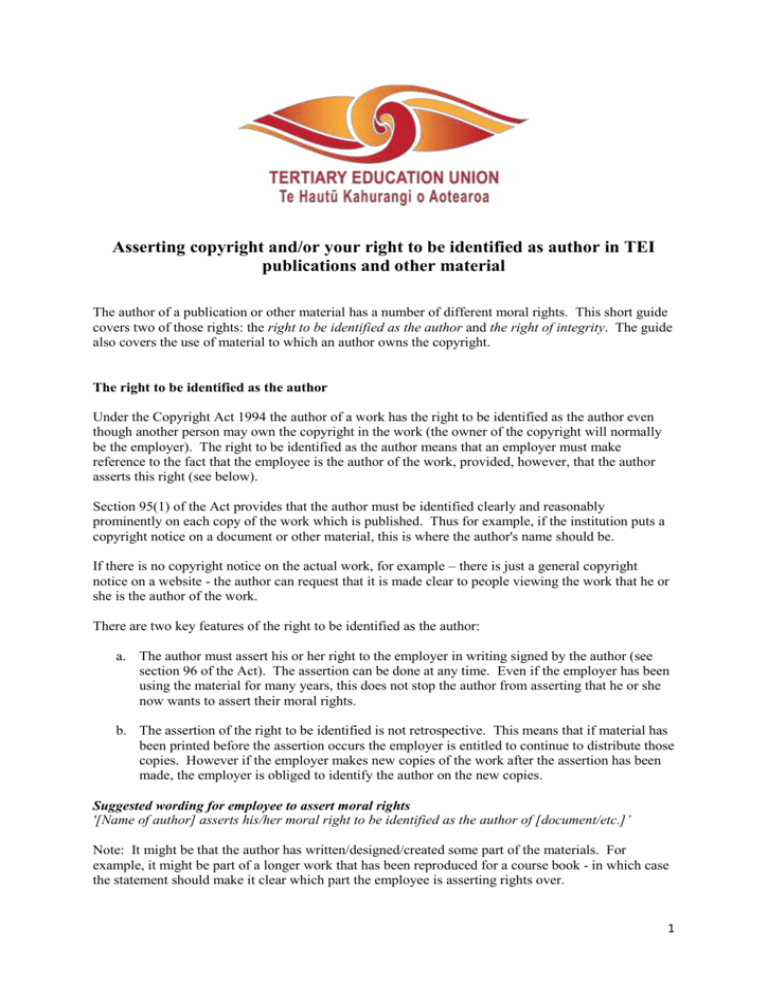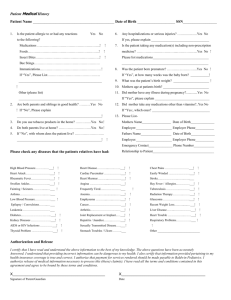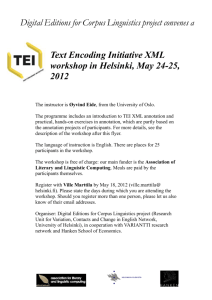Asserting copyright and/or your right to indentified as author in TEI
advertisement

Asserting copyright and/or your right to be identified as author in TEI publications and other material The author of a publication or other material has a number of different moral rights. This short guide covers two of those rights: the right to be identified as the author and the right of integrity. The guide also covers the use of material to which an author owns the copyright. The right to be identified as the author Under the Copyright Act 1994 the author of a work has the right to be identified as the author even though another person may own the copyright in the work (the owner of the copyright will normally be the employer). The right to be identified as the author means that an employer must make reference to the fact that the employee is the author of the work, provided, however, that the author asserts this right (see below). Section 95(1) of the Act provides that the author must be identified clearly and reasonably prominently on each copy of the work which is published. Thus for example, if the institution puts a copyright notice on a document or other material, this is where the author's name should be. If there is no copyright notice on the actual work, for example – there is just a general copyright notice on a website - the author can request that it is made clear to people viewing the work that he or she is the author of the work. There are two key features of the right to be identified as the author: a. The author must assert his or her right to the employer in writing signed by the author (see section 96 of the Act). The assertion can be done at any time. Even if the employer has been using the material for many years, this does not stop the author from asserting that he or she now wants to assert their moral rights. b. The assertion of the right to be identified is not retrospective. This means that if material has been printed before the assertion occurs the employer is entitled to continue to distribute those copies. However if the employer makes new copies of the work after the assertion has been made, the employer is obliged to identify the author on the new copies. Suggested wording for employee to assert moral rights '[Name of author] asserts his/her moral right to be identified as the author of [document/etc.]’ Note: It might be that the author has written/designed/created some part of the materials. For example, it might be part of a longer work that has been reproduced for a course book - in which case the statement should make it clear which part the employee is asserting rights over. 1 Right of integrity The right of integrity gives some protection to an author against changes being made to his or her work without the author’s permission. The right of integrity will be breached if two things occur: (a) There has been a treatment of the work, for example, your work has been changed by someone else, or part of your work has been used elsewhere; and (b) The use of the work is damaging to your honour and reputation. For example, you have written course materials for a course and the TEI gets someone to update the materials so another person can teach the course (= treatment). If, for example, those changes are incorrect and people believe that you are responsible for the incorrect work, your academic reputation may be threatened and your right of integrity will be breached. Note: if no changes have been made to your work, then you cannot invoke the right of integrity. For example, if an author’s course materials are used at another TEI and are being used in a way that the author does not approve of, but the materials have not been altered in any way, then while your honour and reputation may be harmed, there is no change to the right of integrity. Unlike the right to be identified, you do not need to assert your right of integrity. Waiving moral rights Moral rights can be waived by the author (see section 107(2) of the Copyright Act 1994). Once those rights have been waived, the employee is unable to exercise them again in the future. Moral rights can only be waived if done so in writing. It is common however for employment agreements to contain a clause that states that the employee has waived all of his or her morals rights. Members need to check their employment agreements and institution policies to see if this is the case at their institution. Another important point to note is that policies which do not form part of the employment agreement because they are not referred to in this document may not satisfy the ‘in writing’ requirement.1 During the author’s life his or her moral rights cannot be assigned (transferred) to the employer. Moral rights, unlike copyright belong and remain with the author. Therefore, any clause which states that the employer will be the owner of any moral rights in works created by employees is invalid and cannot be enforced. Allowing use of your own work by your employer Occasionally employees will have developed materials and resources in their own time and using their own resources, the copyright of which belongs to the author and not the employer. Example 1: The employee, prior to beginning work at a TEI, developed teaching resources which they are now using or wish to use for their work at the TEI. 1 Policies referring to moral rights/copyright that are not directly referred to in the collective agreement,either individually or as part of an encompassing statement, but that are not inconsistent with the CA may be deemed to cover the issue of waiving these rights – members should discuss this with their branch organiser. 2 Example 2: A person may have had a series of fixed term appointments and created the work between those appointments. For example, someone who is employed to teach over a succession of semesters - employed in two or three blocks of 14-16 weeks to cover teaching and assessments. If they write material before the semester starts - at a time when they are not being paid by the institution (and are therefore not an employee) - the author would be the owner of the copyright in the material. Example 3: An employee is employed in one role which does not involve creating materials, and develops materials in their own time at their home and later is employed in a different role and utilises the materials in that role. For example, a general /allied/professional staff member, who does no teaching, creates materials at home for a course they would like to teach at a later date. If that person changes roles and is now in a teaching position, that person will own the copyright in the materials he or she created prior to taking up that teaching position. As disputes over ownership of copyright can occur, members are strongly advised to ensure that the institution acknowledges that the author is the owner of the copyright in the material before the author begins to use that material at their TEI. If the author has already used the material (or is using the material) the member should request the acknowledgement in writing as soon as possible. On a practical note, it is normally much easier to get the written acknowledgement prior to the work being used in the TEI. Members should not accept verbal assurances that written acknowledgement will be forthcoming. Members should refuse to use that material until they receive written acknowledgement that they own the copyright in the material. In addition, to the written acknowledgement, the author should insist that a statement on the published work be included: "[Person's name] is the owner of the copyright in [xx]. [XX] has been reproduced by [institution's name] under a non-exclusive license." The above statement acknowledges that the author is the owner of the copyright and by including a statement about non-exclusive license authorises others to use it as well. It also means that the author is able to use the material at another institution. November 2011 The TEU thanks and acknowledges Alexandra Sims (University of Auckland) for her assistance and expertise in preparing this guide. 3






